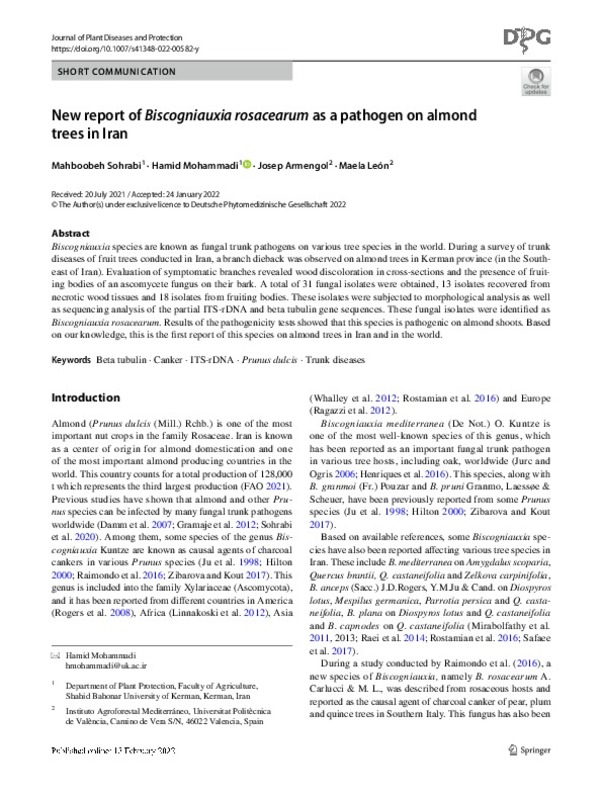Bahmani Z, Abdollahzadeh J, Amini J, Evidente A (2021) Biscogniauxia rosacearum the charcoal canker agent as a pathogen associated with grapevine trunk diseases in Zagros region of Iran. Sci Rep 11:14098
Damm U, Crous PW, Fourie PH (2007) Botryosphaeriaceae as potential pathogens of Prunus species in South Africa, with descriptions of Diplodia africana and Lasiodiplodia plurivora sp. nov. Mycologia 99:664–680
Doyle JJ, Doyle JL (1990) Isolation of plant DNA from fresh tissue. Focus 12:13–15
[+]
Bahmani Z, Abdollahzadeh J, Amini J, Evidente A (2021) Biscogniauxia rosacearum the charcoal canker agent as a pathogen associated with grapevine trunk diseases in Zagros region of Iran. Sci Rep 11:14098
Damm U, Crous PW, Fourie PH (2007) Botryosphaeriaceae as potential pathogens of Prunus species in South Africa, with descriptions of Diplodia africana and Lasiodiplodia plurivora sp. nov. Mycologia 99:664–680
Doyle JJ, Doyle JL (1990) Isolation of plant DNA from fresh tissue. Focus 12:13–15
FAOSTAT (2021) Food and agriculture organization of the United Nations. http://www.fao.org/faostat/es/#dat
Felsenstein J (1985) Confidence limits on phylogenies: an approach using the bootstrap. Evolution 39:783–791
Glass NL, Donaldson GC (1995) Development of primer sets designed for use with the PCR to amplify conserved genes from filamentous ascomycetes. Appl Environ Microbiol 61:1323–1330
Gramaje D, Agusti-Brisach C, Perez-Sierra A, Moralejo E, Olmo D, Mostert L, Damm U, Armengol J (2012) Fungal trunk pathogens associated with wood decay of almond trees on Mallorca (Spain). Persoonia 28:1–13
Granata G, Sidoti A (2004) Biscogniauxia nummularia: pathogenic agent of a beech decline. For Pathol 34:363–367
Hendry SJ, Lonsdale D, Boddy L (1998) Strip-cankering of beech (Fagus sylvatica): pathology and distribution of symptomatic trees. New Phytol 140:549–565
Henriques J, Nóbrega F, Sousa E, Lima A (2014) Diversity of Biscogniauxia mediterranea within single stromata on cork oak. J Mycol article ID 324349:5p
Henriques J, Nóbrega F, Sousa E, Lima A (2016) Analysis of the genetic diversity and phylogenetic relationships of Biscogniauxia mediterranea isolates associated with cork oak. Phytoparasitica 44:19–34
Hilton SEd (2000) Canadian plant disease survey. Agric Agri-Food Can 80:151
Ju YM, Rogers JD (1996) A revision of the genus Hypoxylon. American Phytopathological Society, St. Paul, MN
Ju YM, Rogers JD, San Martin F, Granmo A (1998) The genus Biscogniauxia. Mycotaxon 66:1–98
Jurc D, Ogris N (2006) First reported outbreak of charcoal disease caused by Biscogniauxia mediterranea on Turkey oak in Slovenia. Plant Pathol 55:299–299
Kumar S, Stecher G, Li M, Knyaz Ch, Tamura K (2018) MEGA X: molecular evolutionary genetics analysis across computing platforms. Mol Biol Evol 35:1547–1549
Linnakoski R, Puhakka-Tarvainen H, Pappinen A (2012) Endophytic fungi isolated from Khaya anthotheca in Ghana. Fungal Ecol 5:298–308
Miller MA, Pfeiffer W, Schwartz T (2010) Creating the CIPRES Science Gateway for inference of large phylogenetic trees. In Proceedings of the Gateway Computing Environments Workshop (GCE), New Orleans, LA: IEEE (pp 1–8)
Mirabolfathy M, Groenewald JZ, Crous PW (2011) The Occurrence of charcoal disease caused by Biscogniauxia mediterranea on chestnut- leaved oak (Quercus castaneifolia) in the Golestan forests of Iran. Plant Dis 95:876
Mirabolphathy M (2013) Outbreak of charcoal disease on Quercus spp. and Zelkova carpinifolia trees in forest of Zagros and Alborz Mountains in Iran. Iran J Plant Pathol 49:257–263
Nylander JAA (2004) MrAIC.pl. Program distributed by the editor. Evolutionary Biology Centre, Uppsala University
O’Donnell K, Cigelnik E (1997) Two divergent intragenomic rDNA ITS2 types within a monophyletic lineage of the fungus Fusarium are non orthologous. Mol Phylogenet Evol 7:103–116
Pinna C, Linaldeddu BT, Deiana V, Maddau L, Montecchio L, Lentini A (2019) Plant pathogenic fungi associated with Coraebus florentinus (Coleoptera: Buprestidae) attacks in declining oak forests. Forests 10:1–12
Raei S, Khodaparast SA, Abbasi M (2014) More records of xylariaceous fungi from North of Iran. Rostaniha 15:110–121
Ragazzi A, Ginetti B, Moricca S (2012) First report of Biscogniauxia mediterranea on English ash in Italy. Plant Dis 96:1694
Raimondo ML, Lops F, Carlucci A (2016) Charcoal canker of pear, plum, and quince trees caused by Biscogniauxia rosacearum sp. nov. in Southern Italy. Plant Dis 100:1813–1822
Rogers JD, Vasilyeva LN, Hay FO (2008) New Xylariaceae from Hawaii and Texas (USA). Sydowia 60:277–286
Ronquist F, Teslenko M, van der Mark P, Ayres DL, Darling A, Höhna S, Huelsenbeck JP (2012) MrBayes 3.2: efficient Bayesian phylogenetic inference and model choice across a large model space. Syst Biol 61:539–542
Rostamian M, Kavosi MR, Bazgir E, Babanezhad M (2016) First report of Biscogniauxia mediterranea causing canker on wild almond (Amygdalus scoparia). Australas Plant Dis Notes 11:30
Safaee D, Khodaparast SA, Mirabolfathy M, Mousanejad SA (2017) Multiplex PCR-based technique for identification of Biscogniauxia mediterranea and Obolarina persica causing charcoal disease of oak trees in Zagros forests. Forest Pathol 47:e12330. https://doi.org/10.1111/efp.12330
Sohrabi M, Mohammadi H, León M, Armengol J, Banihashemi Z (2020) Fungal pathogens associated with branch and trunk cankers of nut crops in Iran. Eur J Plant Pathol 157:327–351
Spies CFJ, Mostert L, Carlucci A, Moyo P, van Jaarsveld WJ, Plessis IL, van Dyk M, Halleen F (2020) Dieback and decline pathogens of olive trees in South Africa. Persoonia 45:196–220
Thompson JD, Higgins DG, Gibson TJ (1994) Clustral W: improving the sensitivity of progressive multiple sequence alignment through sequence weighting, position-specific gap penalties and weight matrix choice. Nucleic Acids Res 22:4673–4680
Vaidya GD, Lohman J, Meier R (2011) Sequence Matrix: concatenation software for the fast assembly of multi-gene datasets with character set and codon information. Cladistics 27:171–180
Whalley AJS, Phosri C, Ruchikachorn N, Sihanonth P, Sangvichien E, Suwannasai N, Thienhirun S, Whalley MA (2012) Interesting or rare Xylariaceae from Thailand. Rajabhat J Sci Human Soc Sci 13:9–19
White TJ, Bruns T, Lee S, Taylor J (1990) Amplification and direct sequencing of fungal ribosomal RNA genes for phylogenetics. In: Innis MA, Gelfand DH, Sninsky JJ, White TJ (eds) PCR protocols, a guide to methods and applications. Academic Press, San Diego, CA, USA, pp 315–322
Zibarova L, Kout J (2017) Xylariaceous pyrenomycetes from Bohemia: species of Biscogniauxia and Hypoxylon new to the Czech Republic, and notes on the other rare species. Czech Mycol 69:77–108
[-]









